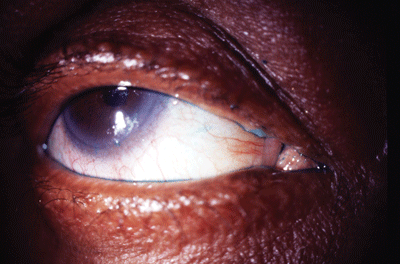 |
Q: A patient who underwent LASIK two years ago presented complaining of severe dry eye. She has seen multiple eye care practitioners with no relief. Other than patches of lissamine staining on her bulbar conjunctiva, the eye is relatively quiet. What are her best options?
A: To decide her best options, determine what is likely causing the condition. There are at least three possible causes following LASIK: the LASIK-induced neurotrophic change in the eye in the early phase of recovery (four to six months out); a concomitant pre-existing disease, such as meibomian gland dysfunction (MGD), in which the patient was asymptomatic until undergoing LASIK; or psychologically-induced dry eye, meaning the patient is convinced that she is never going to get better, and her brain believes that. Given these possible causes, there are several options for this patient:
Inquire about medications that may cause dry eye. Ask the patient what medications she uses, as some may affect tear production. Such medications include (but are not limited to) cold remedies, antihistamines, antidepressants, cholesterol-lowering statins and diuretics.
If she is taking any dry eye causative agents, see if she can discontinue any of them, says ophthalmologist Stephen E. Pascucci, of Bonita Springs, Fla. This may involve calling the patients general practitioner or internist.
 |
| A patient with severe dry eye. Courtesy: Alan G. Kabat, O.D. |
Prescribe omega-3 fatty acids. Prescribe 1,000mg to 1,500mg of omega-3 fatty acid supplements that contain eicosapentaenoic acid (EPA) and docosahexaenoic acid (DHA)both are found in cold-water fishfor one month. These may improve the ratio of non-inflammatory omega-3 oils to the inflammatory omega-6 oils that she consumes, says ophthalmologist Robert Abel Jr., of Wilmington, Del. After a month, decrease the dosage by half, and follow-up with her, he says.
Prescribe Restasis (cyclosporine 0.05%, Allergan). It increases tear production and may reduce inflam-mation. Prescribe it b.i.d. in conjunction with non-preserved artificial tears or Systane Free liquid gel (Alcon) b.i.d. or up to six times a day, if needed, say Drs. Epstein and Pascucci.
Prescribe warm compresses. Consider the Eye Warmer (Kao Corp.)a product found to im-prove the stability and uniformity of the tear lipid layer in MGD patients by melting the meibomian gland lipid.1
Recommend autologous serum. This may be an effective treatment for patients who have post-LASIK neurotrophic corneas, but it may only work in the early phase of recovery. It provides epidermal growth factor, vitamin A and other tear components to the eye surface.2
Recommend punctal occlusion. If none of the above suggestions alleviate the patients symptoms, recommend punctual occlusion to complement the Restasis. If youre going to preserve and back up tears, preserve the stable tears versus the tears with the inflammatory components. Thats the advantage of using Restasis first, says Dr. Pascucci.
Refer the patient to a mental health professional. Since this patients dry eye may be psychologically-induced, refer her to a practitioner who can assess the psychological component.
1. Mori A, Shimazaki J, Shimmura S, et al. Disposable eyelid-warming device for the treatment of meibomian gland dysfunction. Jpn J Ophthalmol 2003 Nov-Dec;47(6):578-86.
2. Gutman C. Dry eye after LASIK can have functional consequences: Management of this condition essential to ensure patient satisfaction after procedure. Ophthalmology Times. www.ophthalmologytimes.com/ophthalmologytimes/article/articleDetail.jsp?id=115666 Accessed March 17, 2006.

